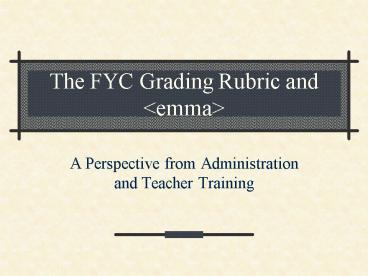The FYC Grading Rubric and emma - PowerPoint PPT Presentation
1 / 16
Title:
The FYC Grading Rubric and emma
Description:
The FYC Grading Rubric and emma A Perspective from Administration and Teacher Training ... Advantages of emma Teachers' evaluation of students. Students' ... – PowerPoint PPT presentation
Number of Views:60
Avg rating:3.0/5.0
Title: The FYC Grading Rubric and emma
1
The FYC Grading Rubric and
- A Perspective from Administration and Teacher
Training
2
Advantages of
- Teachers evaluation of students
- Students evaluation of themselves
- Administrators evaluation of teachers
- Program assessment
- Research in composition
3
Evaluation What was that assignment?
Assignment linked to commented essay
4
Did the assignment work?
- Teachers, students, and administrators see
whether students essays have addressed the
assignment. - Teachers, students, and administrators see
whether teachers are grading according to the
assignments criteria.
5
Evaluation How well did the student revise?
Side-by-side display of draft and final essay
6
Evaluation Why this grade?
Rubric inserted automatically
7
Do comments explain the grade?
She said my essay was distinguished, but I only
got a B!
8
A Holistic Approach to Evaluation
- Encourages self-consciousness
- Helps teachers and students see writing
assignments through the same lens - Allows both groups to see student essays in
unified pedagogical context.
9
Program Assessment
- Large database of digital student essays with
- Assignments
- Peer and/or teacher comments
- Grades
10
FYC/Library Collaboration Student Citation
Behavior
11
Further research questions
- How did the teachers wording of her assignment
affect students understanding of research? - What kinds of sources do teachers marginal and
end comments suggest are valued most highly by
the First-year Composition Program? - Is there a correlation between numbers of
citations and grades? - Does formal intervention of a librarian improve
the quality of students sources?
12
Return to basics . . .
- How do research and assessment help
- Students?
13
Return to basics . . .
- How do research and assessment help
- Students?
- Teachers?
14
Return to basics . . .
- How do research and assessment help
- Students?
- Teachers?
- Teacher-trainers?
15
Return to basics . . .
- How do research and assessment help
- Students?
- Teachers?
- Teacher-trainers?
- Administrators?
16
The End
- Thanks for coming.






























